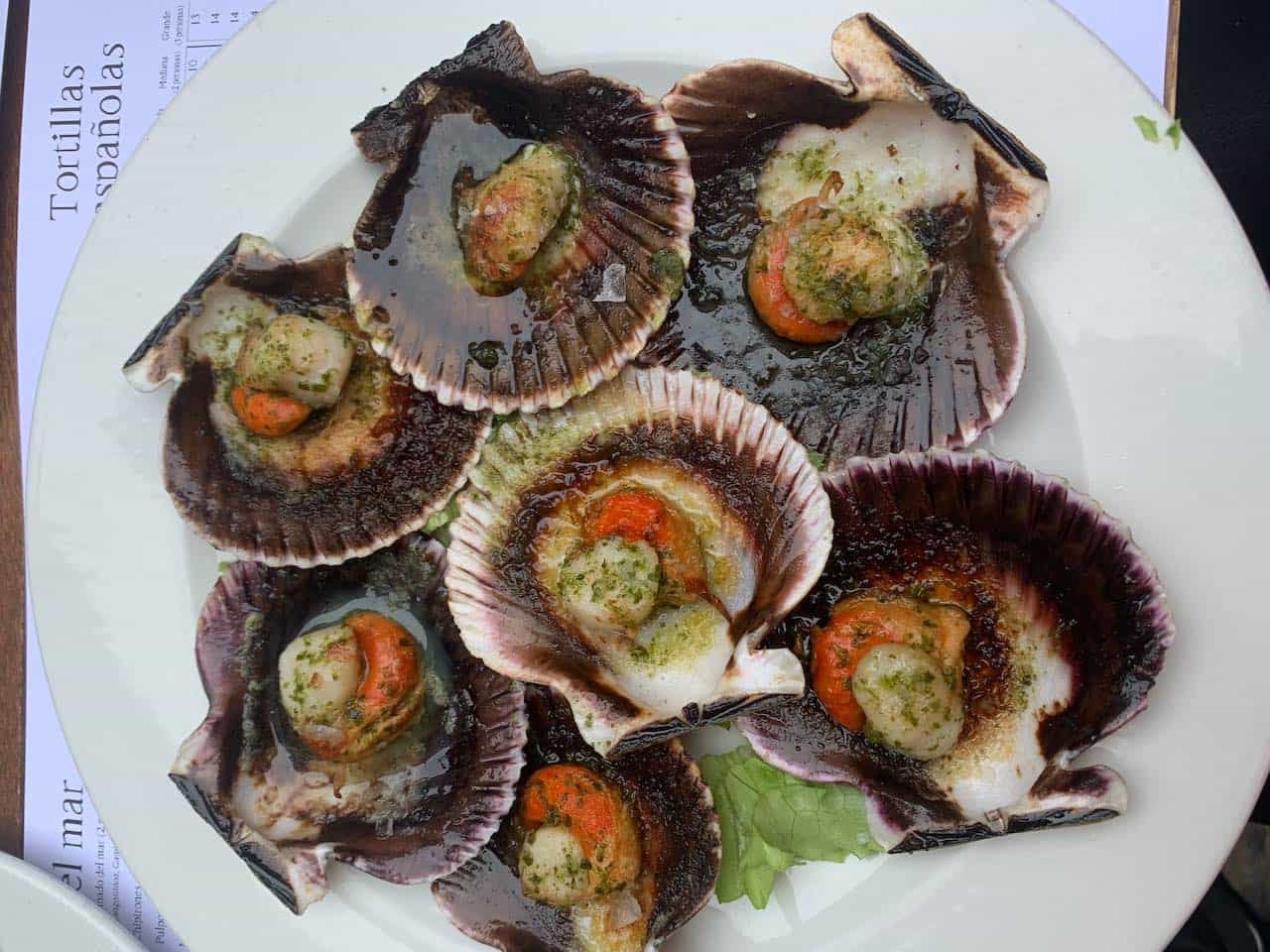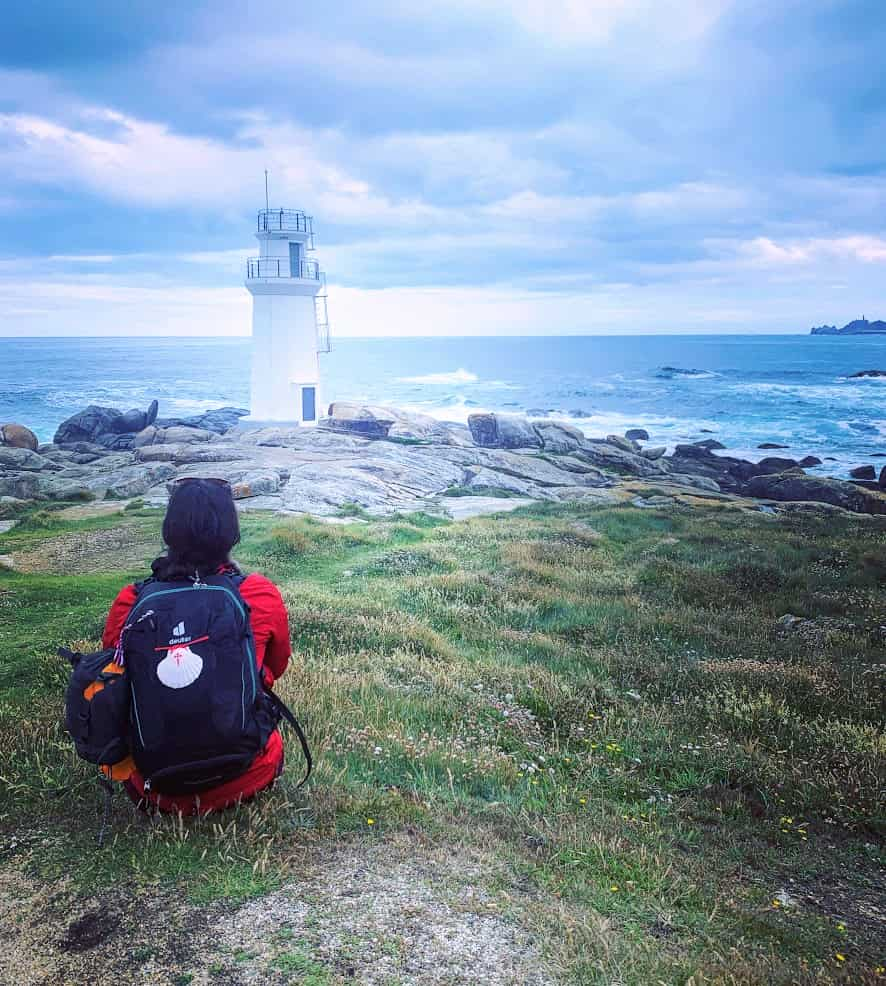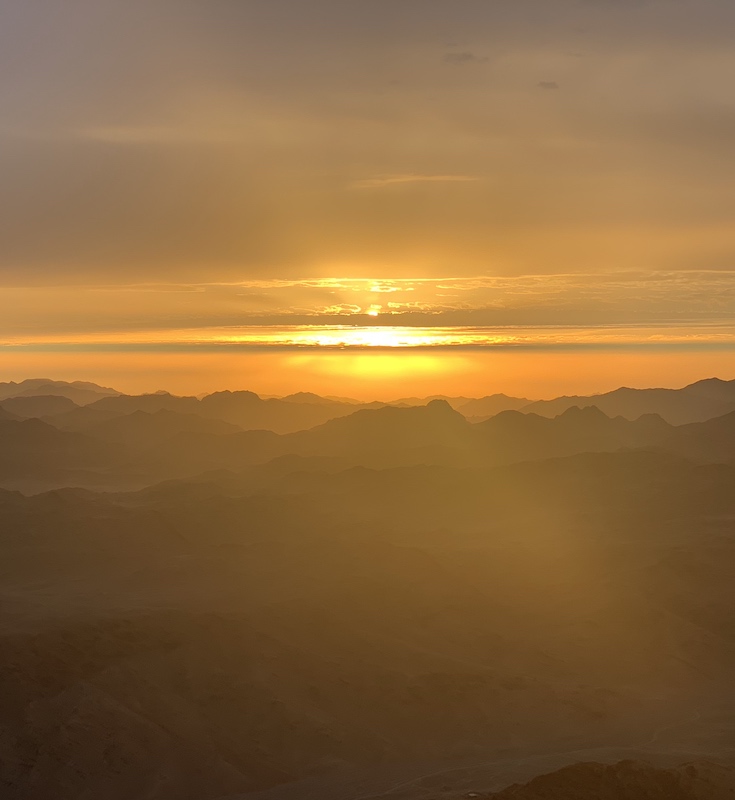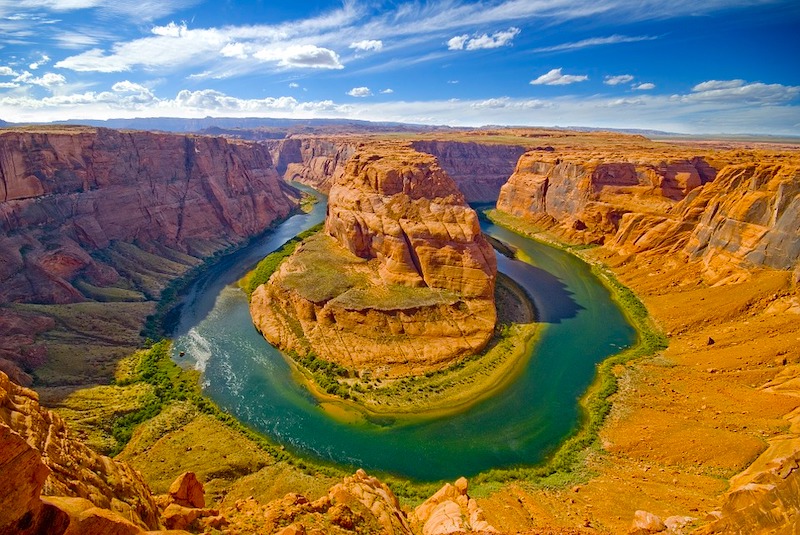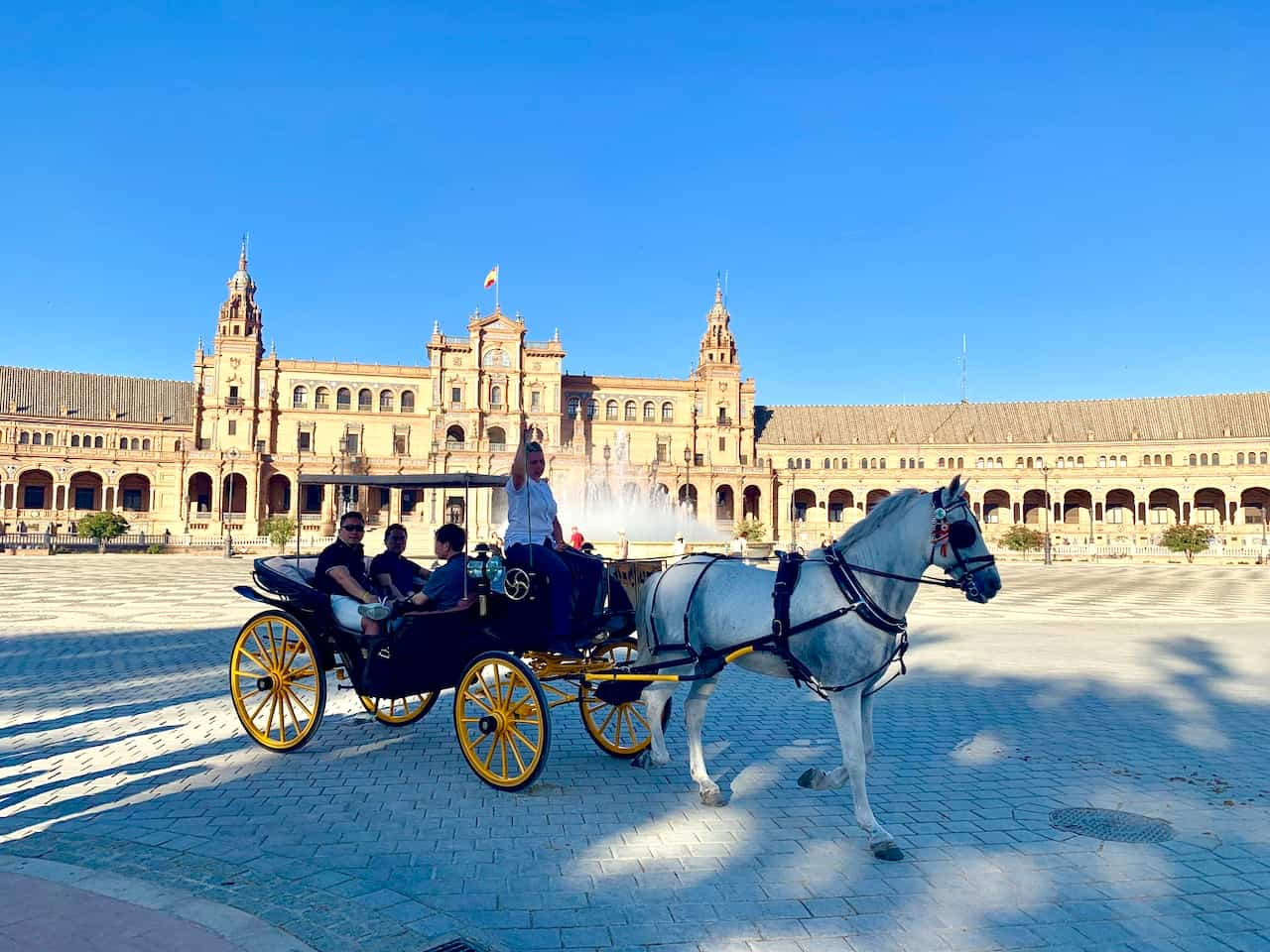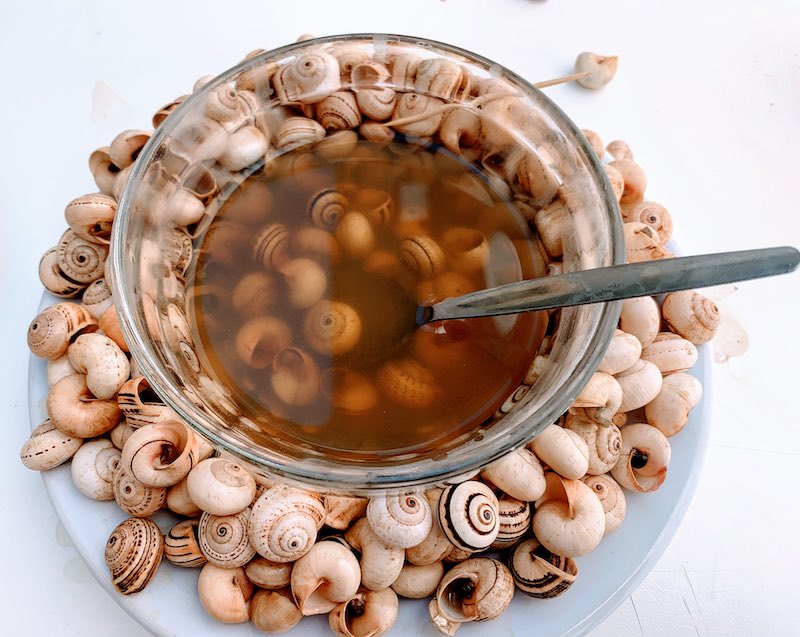Camino de Santiago: Via de la Plata Guide
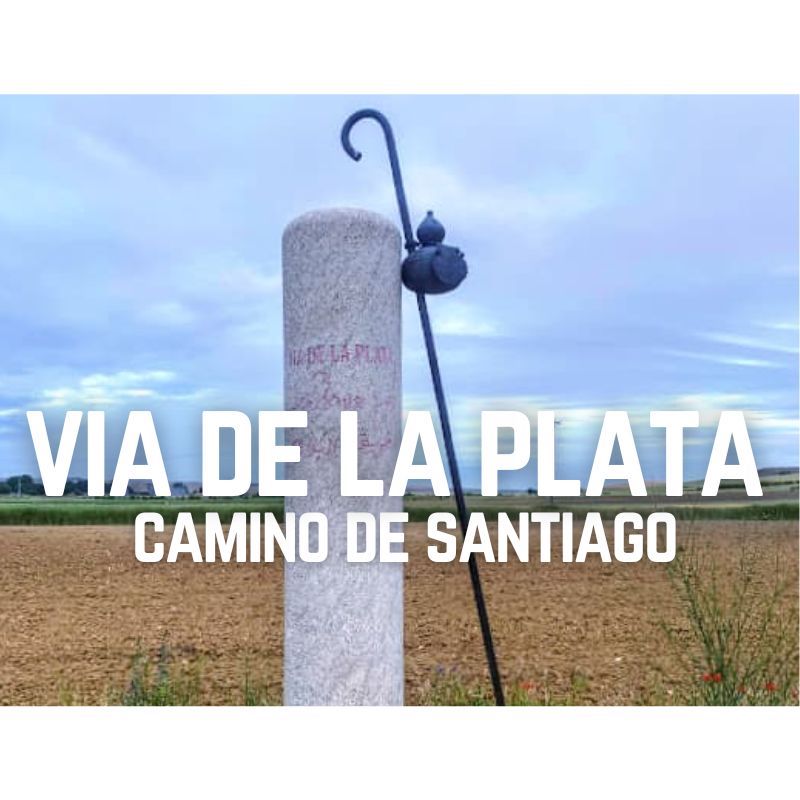
Thinking of walking the La Via de la Plata route of the Camino de Santiago in Spain?
The Via de la Plata is one of the oldest, the longest, historically the most important, and the most challenging Camino de Santiago routes.
At the same time, La Via de La Plata connects some of the most spectacular places and beautiful cities in Spain (Seville, Salamanca, Santiago) from the south to the north of Spain.
- LA VIA DE LA PLATA
- VIA DE LA PLATA SUMMARY
- VIA DE LA PLATA NAME
- VIA DE LA PLATA DIFFICULTY
- VIA DE LA PLATA TERRAIN
- VIA DE LA PLATA ROUTE
- HIGHLIGHTS OF LA VIA DE LA PLATA via CAMINO SANABRES
- WHERE TO START VIA DE LA PLATA
- WHERE TO GET VIA DE LA PLATA CREDENTIAL
- VIA DE LA PLATA WAYMARKERS
- VIA DE LA PLATA STAGES
- VIA DE LA PLATA ACCOMODATION
- BEST TIME TO WALK VIA DE LA PLATA
- PACKING LIST FOR CAMINO VIA DE LA PLATA
- VIA DE LA PLATA MAP
LA VIA DE LA PLATA
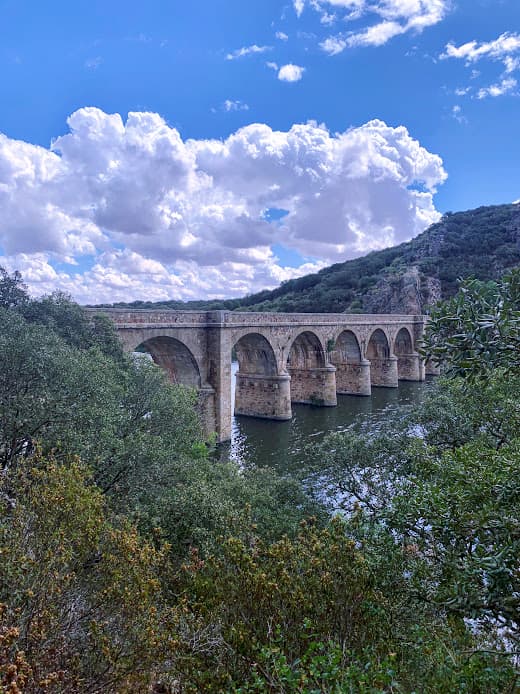
THIS POST MAY CONTAIN COMPENSATED LINKS. PLEASE READ MY DISCLAIMER FOR MORE INFO.
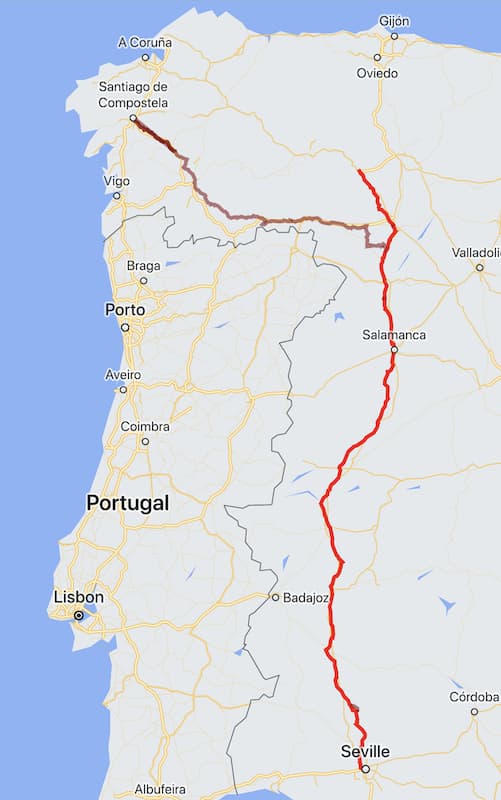
The Via de la Plata (the Silver Way) is one of the most important historic Camino de Santiago routes.
Mighty Via de la Plata is an ancient Roman road that crosses Spain from south to north.
This ancient paved Roman road had a huge importance in history. It connected two important Roman towns: Merida (Emerida Augusta) and Astorga (Asturica Astorga).
Romans, Arabs (Moors during their conquest of the Iberian peninsula,) and Spaniards (during the Reconquest) used the ancient Via de la Plata in the past.
The Camino de la Plata is also one of the oldest Camino de Santiago routes.
Pilgrims walked Via de la Plata on their way to Santiago de Compostela in the Middle Ages.
Historical Camino de la Plata started in Merida. Today the most popular starting point for Camino de la Plata is Seville (instead of Merida).
However, the Camino de la Plata can be started from Cadiz, 75 mi (120 km) south of Seville. The route from Cadiz is well-signposted with the Camino Way markers.
Despite that, nowadays the most popular starting point of the Via de la Plata is Seville.
VIA DE LA PLATA SUMMARY
Starting point: Seville in Andalucia
Finishing point: Astorga in Leon (in Astorga the route joins Camino Frances)
Camino Via de La Plata length: 702 km (+ 283 km from Astorga to Santiago via Camino Frances)
Camino Via de La Plata etapas: 37 stages in total
Camino Via de La Plata days: 7 weeks on average
Camino Via de La Plata min/max elevation: 5 m / 1147 m
Camino Via de La Plata elevation gain/loss: 7857 m / – 6995 m
Camino Via de La Plata best time to go: April, May, and October
Camino Via de La Plata type of pilgrims: solitude fans, inner journey seekers, long-distance trails lovers, Camino veterans (pilgrims who already walked one or more Camino routes)
Percentage of pilgrims who walk Via de La Plata: about 3%
VIA DE LA PLATA NAME
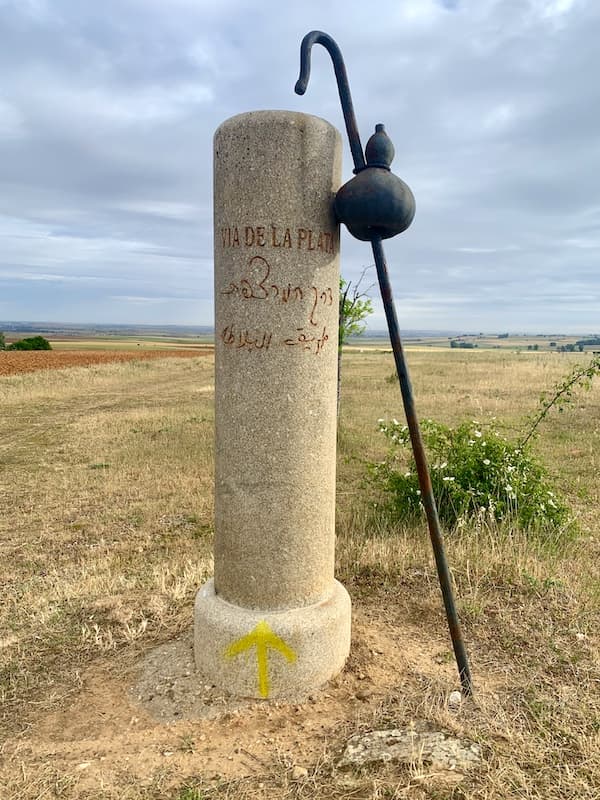
Via de la Plata, literally means the Silver Way.
But despite its name, the Silver Way is not related to silver in any way.
There are several possible origins of the name. The name might come from the Latin word ‘platea’ meaning ‘wide road’, or ‘lapidata’ meaning ‘stone road’, or the Arabic ‘batata’ meaning ‘paved road’.
VIA DE LA PLATA DIFFICULTY
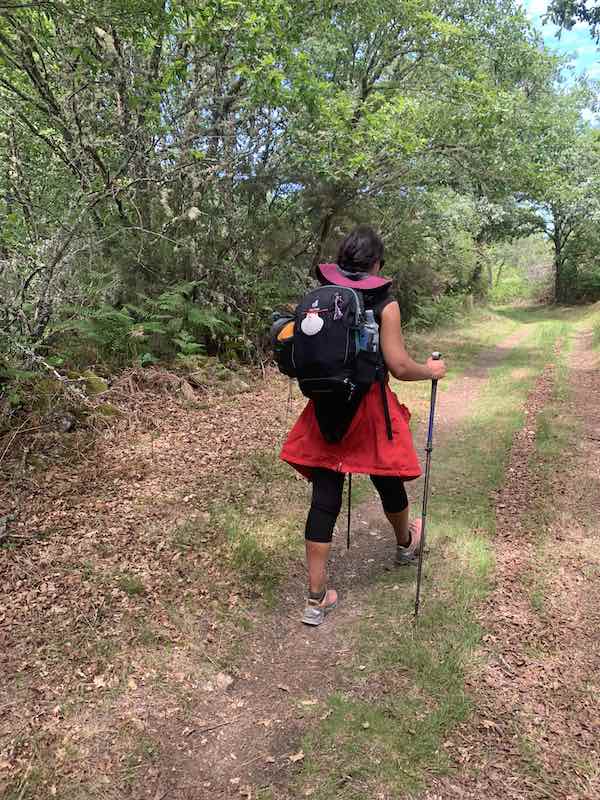
The Camino de la Plata is considered the most challenging Camino de Santiago route.
Despite being mostly flat, the route is known for long stages (many stages are over 18 mi – 30 km), with no facilities between the stages (no villages, no buildings, no bars, no restaurants, no shops, no people … only plains, fields, meadows .. ), accompanied with strong (in summer even unbearable) heat and lots of solitude.
The Via de la Plata route of Camino de Santiago is liked by people who enjoy solitude and serenity.
Via de la Plata is one of the least walked Camino de Santiago routes, unlike the Camino Frances (the French Way) which is the most popular (read: crowded).
Only about 3% of Camino de Santiago pilgrims take the Via de la Plata route, while 55% of the pilgrims take Camino Frances.
Camino de la Plata is highly recommended for bicyclists because of its flatness and long-distance stages.
Via de la Plata is not recommended for first-time walkers of Camino. Via de la Plata peregrinos are usually Camino veterans (people who have already walked one or more Camino routes).
The Camino de la Plata is also one of the longest Camino de Santiago routes. Via de la Plata from Seville to Santiago is 622 mi (1000 km) long.
Only Camino Mozarabe from Almeria is longer than Camino de la Plata. The Camino Mozarabe is 933 mi (1500 km) long. In fact, Camino Mozarabe from Almeria joins Via de la Plata in Merida. That’s why there are also Camino way markers for the Camino Mozarabe on the Via de la Plata from Merida.
Let me make a quick digression here, in case you are wondering what Mozarabe means. Christians who lived in Arab Al-Andalus in southern Spain were called Mozarabs. The faithful Mozarabs walked the Camino Mozarabe from their homes to Santiago de Compostela during the Al-Andalus times.
To make it short, the 622 mi Via de la Plata is one of the longest Camino de Santiago routes. It takes about 7 weeks on average to walk the entire Via de la Plata route (from Seville to Santiago).
RELATED READ: How long is Camino de Santiago?
VIA DE LA PLATA TERRAIN
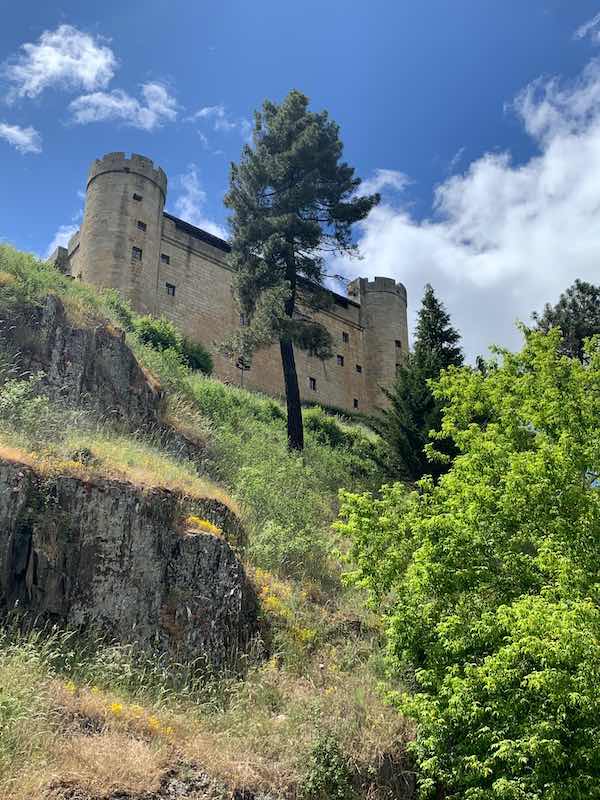
Via de la Plata goes from Andalucia, across Extramadura, and Castilla y Leon to Galicia.
The route leads through diverse landscapes.
The landscapes along Via de la Plata change from olive groves and vineyards in Andalusia and undulating plains in Extremadura, across prevailing meadows and cereal fields in Castilla e Leon to the authentic ‘Dehesa‘ pasture farms and oak and eucalyptus forests in Galicia.
The Via de la Plata goes through plains, fields, woodlands, and historic and spectacular cities, and towns (Seville, Mérida, Cáceres, Salamanca, Zamora, Ourense, and Santiago).
VIA DE LA PLATA ROUTE
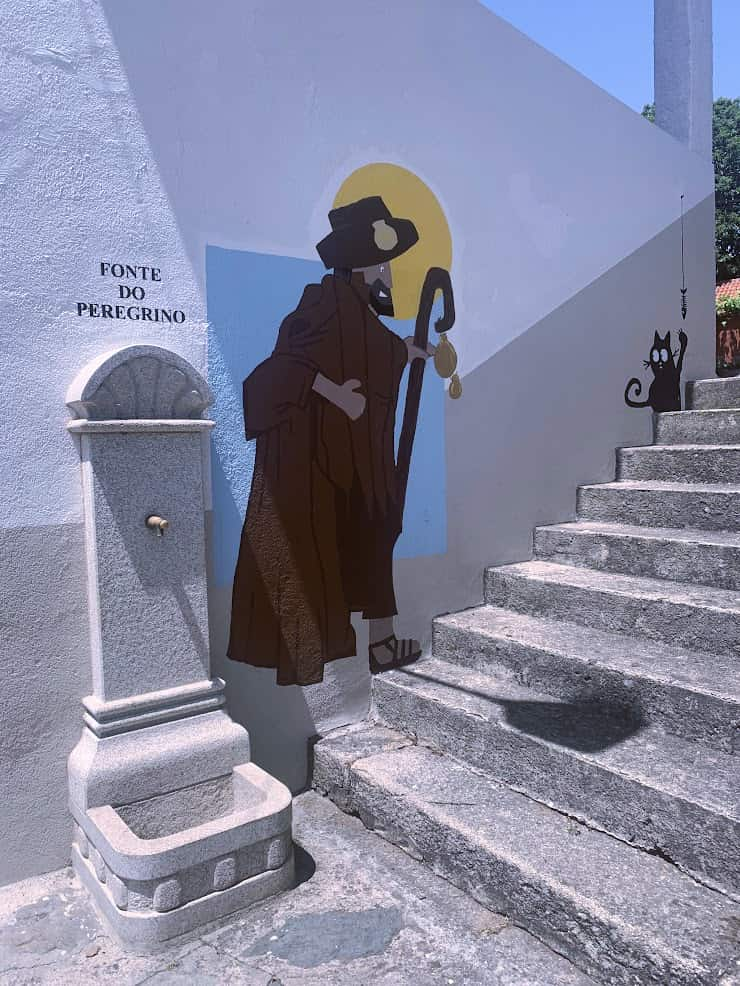
The Camino de la Plata has two main variants: the Galician variant (via Astorga) and the Camino Sanabres (via the Sanabria area).
VIA DE LA PLATA VIA ASTORGA (the Galician variant)
The Via de La Plata splits in Granja de la Moreruela municipality (18 mi – 30 km north of Zamora) into two main branches: the Galician variant and the Camino Sanabres.
The Galician variant goes to Astorga, and in Astorga joins the Camino Frances (the French Way) which leads to Santiago.
Via de la Plata from Seville to Astorga is 702 km long. 283 km take from Astorga to Santiago.
CAMINO SANABRES (the Sanabres Way)
The Camino Sanabres goes from Granja de la Moreruela (a small municipality after the town of Zamora) the southwest to the town of Ourense in Galicia and finally to Santiago.
Camino Sanabres is more popular than the Galician variant (Via de La Plata via Astorga route) among pilgrims since many of the Via de la Plata pilgrims have already walked Camino Frances or they are the kind of people who enjoy walking in solitude and serenity (what is less possible on the crowded Camino Frances).
CAMINO ZAMORANO PORTUGUES
An interesting fact, there’s a possibility of taking the so-called Camino Zamorano Portugués from Zamora.
The Camino Zamorano Portugués goes from Zamora in Spain to Braganca in Portugal and comes goes back to Spain in Galicia.
The Camino Zamorano Portugués joins the Camino Sanabres in Verin in Galicia. There is 60 mi (98 km) from Zamora via Braganca to Verin and 115 mi (184 km) from Verin to Santiago. The Camino Zamorano Portuguese is 11.3 mi (18 km) shorter than the Camino Sanabres.
CAMINO FONSECA
The part of the Via de la Plata route from Salamanca to Santiago via the Sanabres Way is also known as Camino Fonseca. It is named after archbishop Archbishop Alonso de Fonseca III, an important figure in the history of Salamanca and Santiago. Honoring him, there are Archbishop Fonseca College in Salamanca and Fonseca College in Santiago de Compostela.
HIGHLIGHTS OF LA VIA DE LA PLATA via CAMINO SANABRES
SEVILLE, ANDALUCIA
Seville is one of the most beautiful cities in Spain.
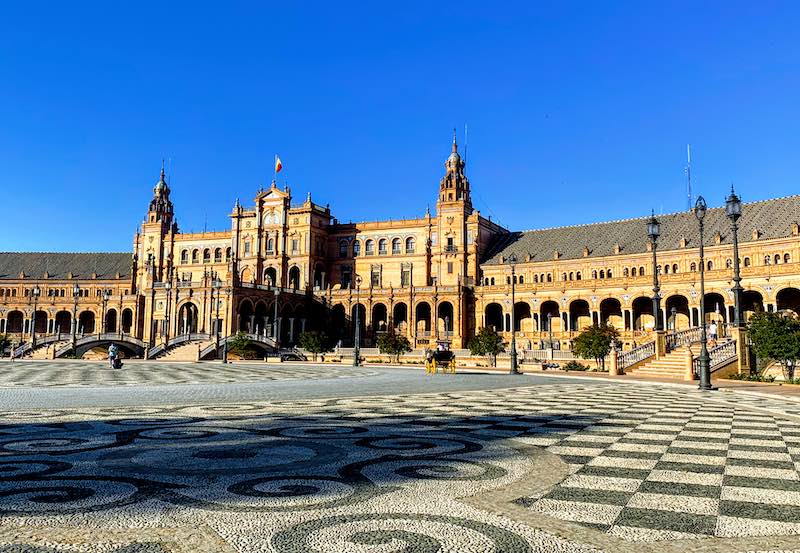
The complex of Cathedral, Alcázar, and Archivo de Indias in Seville is a UNESCO World Heritage site.
And, Plaza de Espana in Seville is one of the most beautiful squares in the world. Seville is one of those amazing cities in the world that are a must-see in a lifetime.
READ MORE: Best Things to Do in Seville
MERIDA, EXTREMADURA
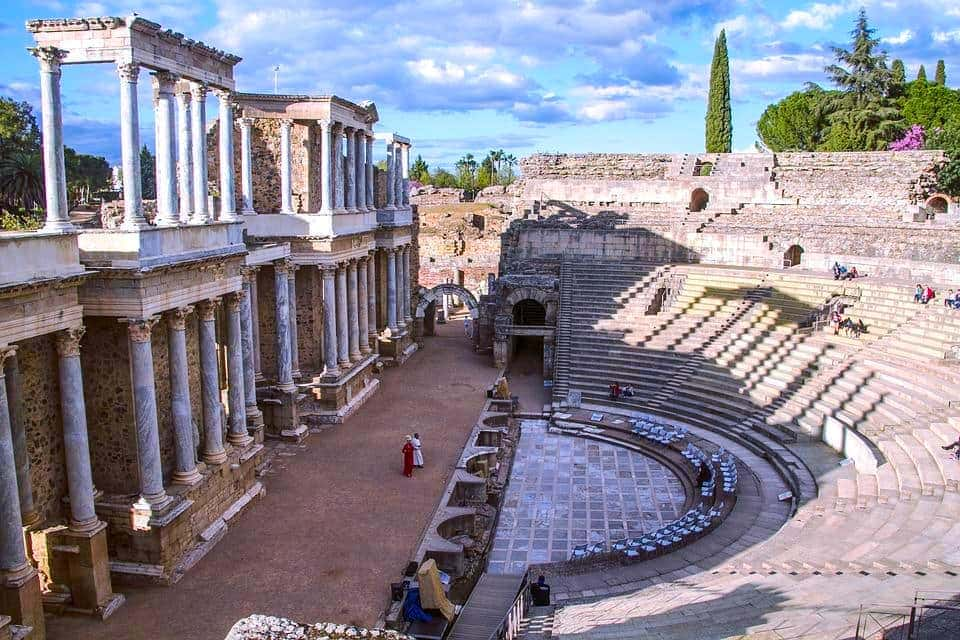
Romans founded Merida.
Ancient Roman Merida was called Emerita Augusta. Emerita Augusta was one of the most important cities in the Roman Empire.
Today’s Merida holds some of the best-preserved Roman buildings in Spain: the Guadiana bridge, Amphitheatre, Theatre, Temple of Diana, Residences, Water supply system, Baths, Tombs, Arch of Trajan, and Circus.
The Archaeological Ensemble of Mérida is a UNESCO World Heritage Site.
CACERES, EXTREMADURA
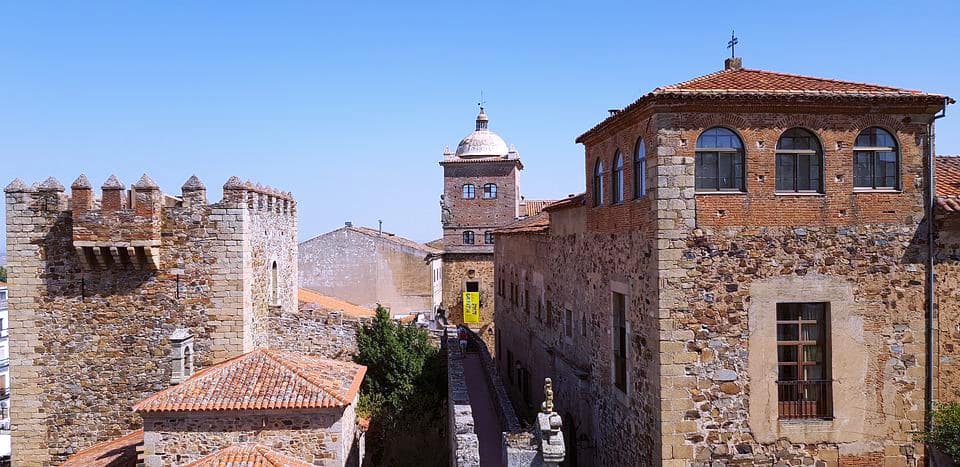
Cáceres is another historic city in Extremadura and a must-see city in Spain.
Caceres is a marvelous city with buildings built in Roman, Islamic, Northern Gothic, and Italian Renaissance styles. The stunning architecture reflects the turbulent history of Cáceres.
The Old Town of Cáceres is a World Heritage Site. The extraordinarily preserved Old Town was a filming location for the TV series Game of Thrones.
SALAMANCA, CASTILLA AND LEON
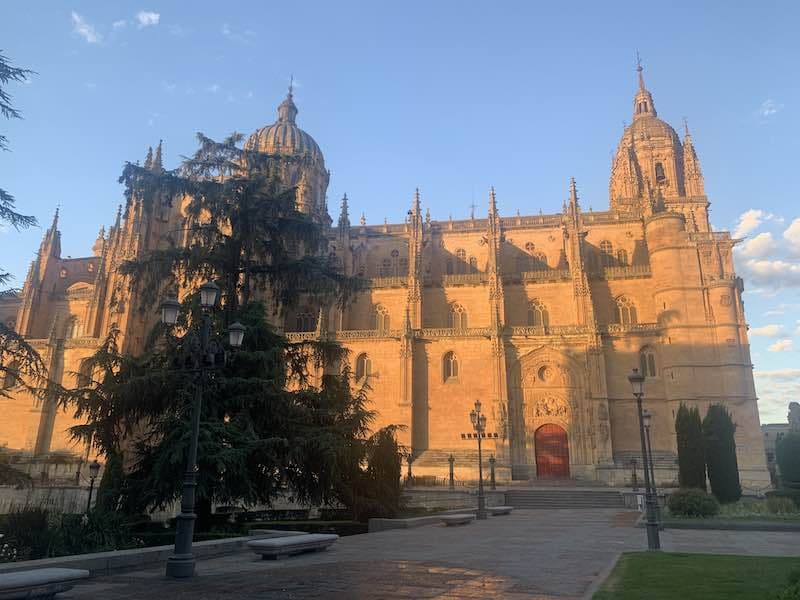
The Old City of Salamanca is also a World Heritage Site.
Salamanca is one of the most beautiful cities in Spain. It is a must-visit city in Spain for people who enjoy history, historical sites, wonderful medieval architecture, and authentic Spanish culture.
Mesmerizing Salamanca is known for its authentic Spanish charm.
Salamanca University is the oldest university in Spain. Salamanca’s Baroque Plaza Mayor is known as the most beautiful square in Spain, while the Old Cathedral and New Cathedral complex in Salamanca is one of the most magnificent sacral monuments in Spain.
ZAMORA, CASTILLA AND LEON
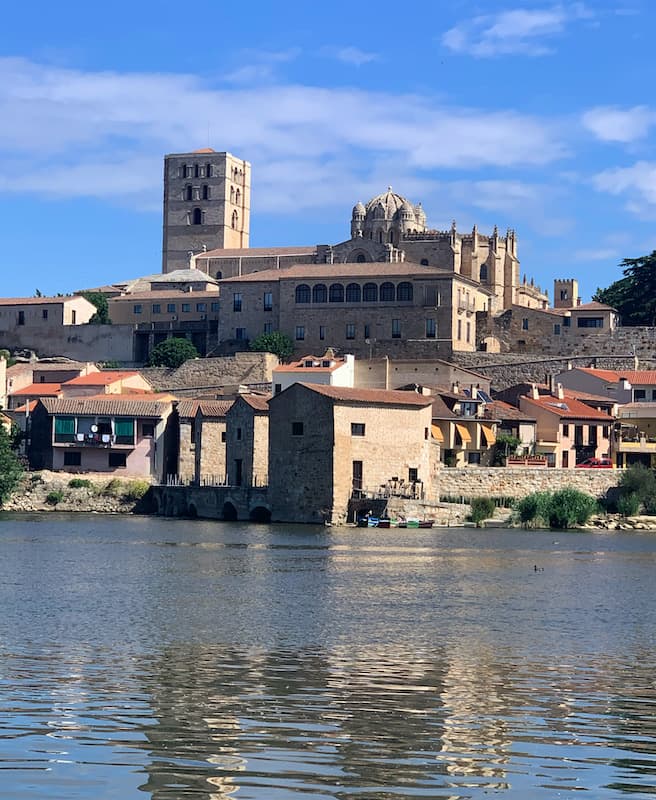
Zamora in Castilla and Leon is a hidden gem in Spain.
The cliff-standing medieval town of Zamora on the river Duaro is absolutely breathtaking.
The town of Zamora holds the largest number of Romanesque churches in Europe. Therefore, Zamora is nicknamed ‘The Romanesque city’.
Zamora stands on the so-called Transromanica, the Romanesque routes of European Heritage, and a major cultural route of Europe.
Medieval Zamora had a strategic position and stood at a crossroads of trade routes.
Even today, in Zamora on the Camino Via de la Plata you can choose between the path to Astorga, the path to Sanabria, and the Camino Zamorano Portugues path while proceeding to Santiago de Compostela.
PUEBLA DE SANABRIA, CASTILLA AND LEON
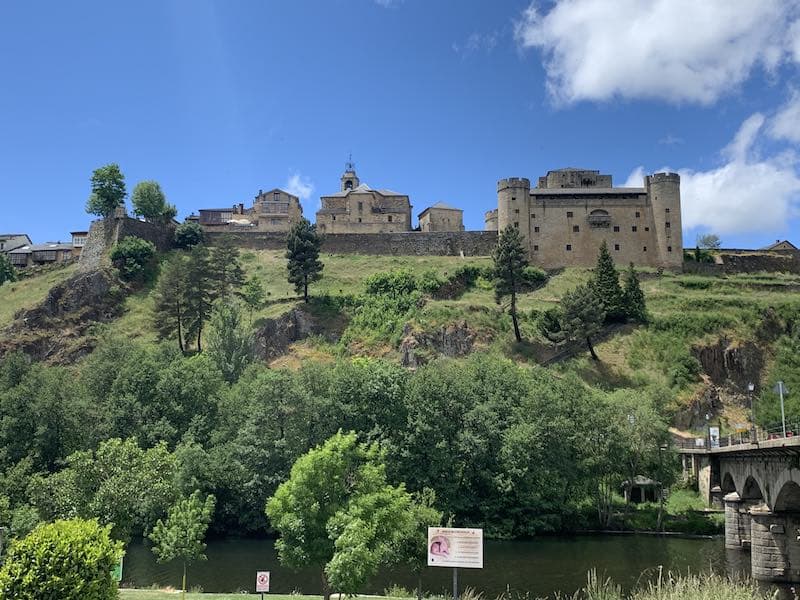
Puebla de Sanabria is another fairy tale town in Castilla and Leon on the Via de La Plata route.
The town of Puebla de Sanabria in the Sanabria region is a well-preserved walled and fortified medieval town. Just like the above-mentioned Zamora, Puebla de Sanabria had a strategic position in the Middle Ages.
It is one of the most picturesque towns in Spain and a popular tourist destination among Spaniards. The beautiful medieval town of Pueblo de Sanabria reminded me of Santillana del Mar in Cantabria on the Camino del Norte route.
OURENSE, GALICIA
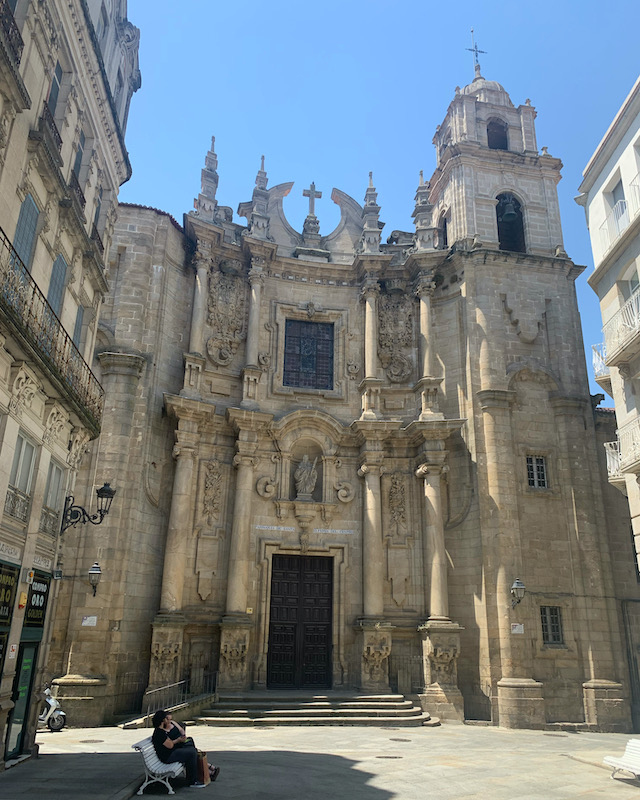
Ourense is one of the most important historic cities on the Ruta de la Plata. The city is one of the largest cities in Galicia, larger than Santiago de Compostela.
Ourense on the Camino Sanabres path is known for its Roman heritage and thermal baths.
The monumental Roman bridge across the river Miño is a symbol of Ourense while several geothermal springs with water between 37 and 60 C degrees make Ourense a popular spa destination in Spain.
Put your tired pilgrim’s legs into thermal waters in Ourense and relax in Ourense on your pilgrimage to Santiago.
OSEIRA MONASTERY, GALICIA
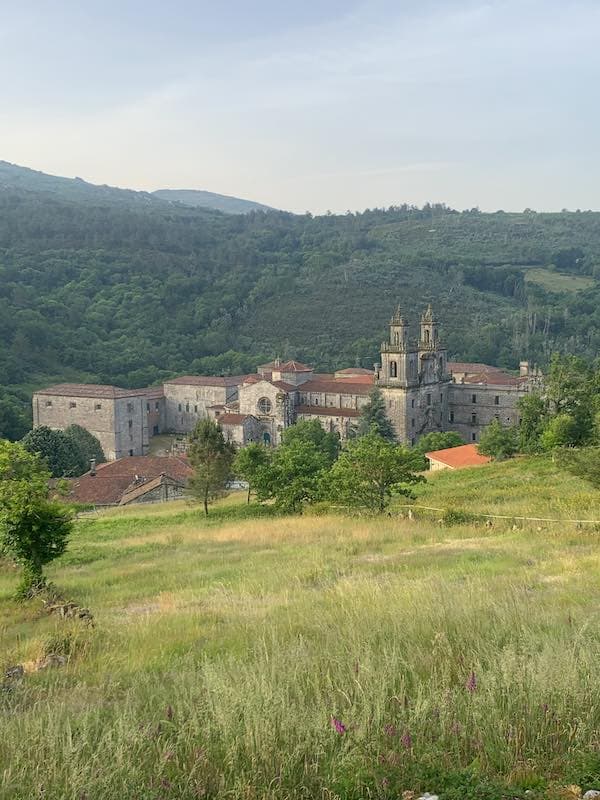
The masterpiece Monastery of Santa María de Oseira is one of the oldest Cistercian monasteries on the Iberian peninsula. It was founded in the 12th century.
This monumental monastery is called the Galician El Escorial.
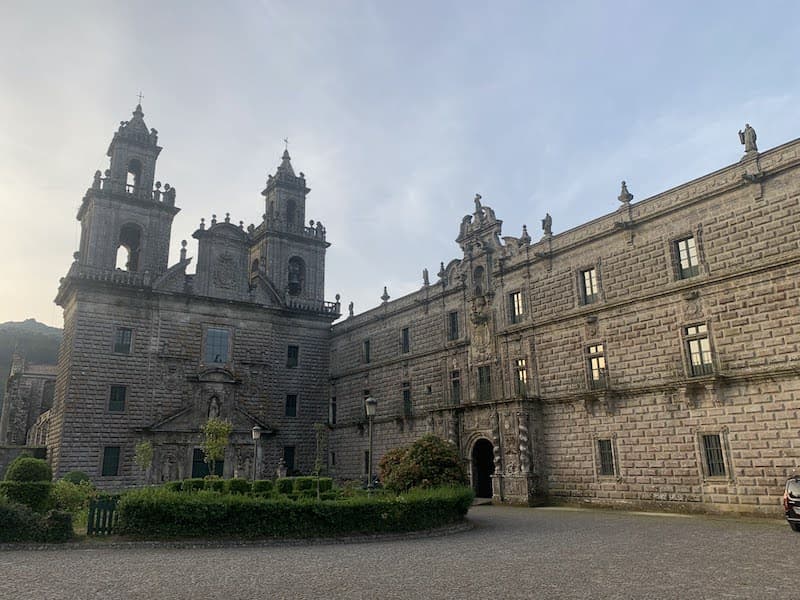
Oseira monastery is in the Ourense province, a 8 km detour from Cea on the Ruta via de la Plata.
There is a pilgrim’s hostel within the monastery complex. The impressive Oseira monastery is a must-see on the Via de la Plata of Camino de Santiago. Please don’t miss visiting it!
The Trappist monks organize spiritual retreats in the monastery. The minimum stay is 2 nights and a maximum of 7 days.
WHERE TO START VIA DE LA PLATA
You start hiking the Via de la Plata route in Seville and hike 1000 km from Seville to Santiago de Compostela.
You can start hiking Via de la Plata in Salamanca and hike 500 km from Salamanca to Santiago de Compostela.
Or, you can start hiking Via de La Plata in Ourense in Galicia and hike the last 100 km of the Via de la Plata route from Ourense to Santiago de Compostela to get the Compostela (the Camino certificate)
If you don’t have much time to spend more time on the Camino via de la Plata and you still want to get your Compostela (the Camino certificate), you can start the Camino in Ourense in Galicia.
The last 100 km of the Camino starts in the city of Ourense in Galicia.
If you start Via de la Plata in Seville, you might be interested in attending the Holy Mass with Pilgrims’ Blessing in the Royal Chapel of Seville Cathedral. The Mass with the Blessing is in the Royal Chapel of Seville Cathedral every day at 8.30 am.
WHERE TO GET VIA DE LA PLATA CREDENTIAL
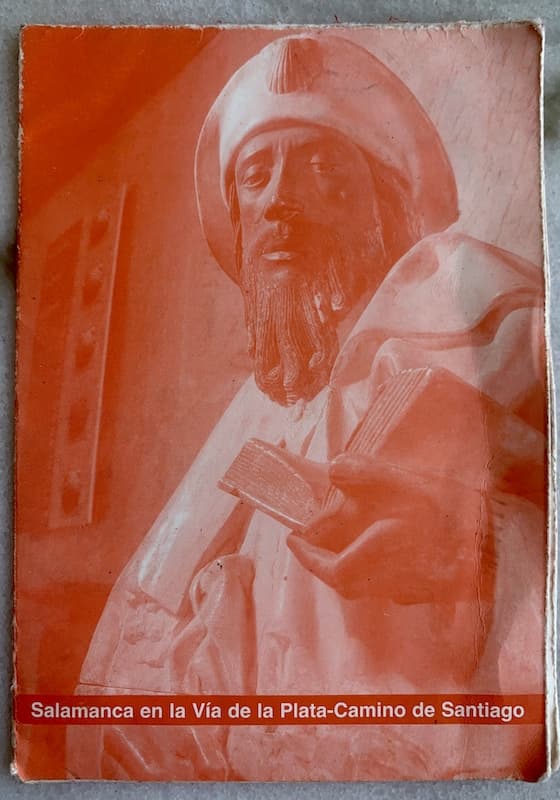
A pilgrim’s passport (a Credential) is an important document for walking the Camino de Santiago.
Camino de Santiago Pilgrim’s Credential is a pilgrim passport that documents the dates and places visited on the Via de la Plata route. The sealed stamps (with the dates and places) collected in the passport serve as proof of a pilgrimage journey.
Pilgrims can seal their credentials in accommodations, bars, restaurants, churches, and tourist offices along the route.
Pilgrims need to have a stamp for each stage (day) of their Camino.
Only pilgrims who have the Credentials can sleep in public hostels (albergues de peregrinos) for pilgrims. Some private hostels don’t ask for the Creditenials though.
You can always get your Credential from your national Camino association in advance.
Via de la Plata Credenciales are available in larger municipal albergues in major towns and cities along the La Via de la Plata route.
A Pilgrim’s Credential costs 3 EURO.
Where to get the Camino Credential in Seville?
You can get your credential at the Cathedral of Seville (the Cathedral Parochial Office) , and at the Asociación Amigos del Camino de Santiago en Sevilla (address: Calle San Jacinto 25, Seville, and it is on the Camino route)
Where to get the Camino Credential in Merida?
Albergue de peregrinos Molino de Pancaliente (Av. José Fernández López, s/n, Merida) issues the credentials.
Where to get the Camino Credential in Salamanca?
Albergue de peregrinos Casa la Calera in Salamanca (C. Arcediano, 14, Salamanca) issues credentials. Also the Bishopric of Salamanca (c. Rosario, s/n, Salamanca), issue them.
Where to get the Camino Credential in Ourense?
The Ourense Cathedral and the Asociación Amigos do Camiño de Santiago por Valdeorras (Rúa Urb. Losada, 15, 32350 A Rúa, Ourense) issue the credentials.
VIA DE LA PLATA WAYMARKERS
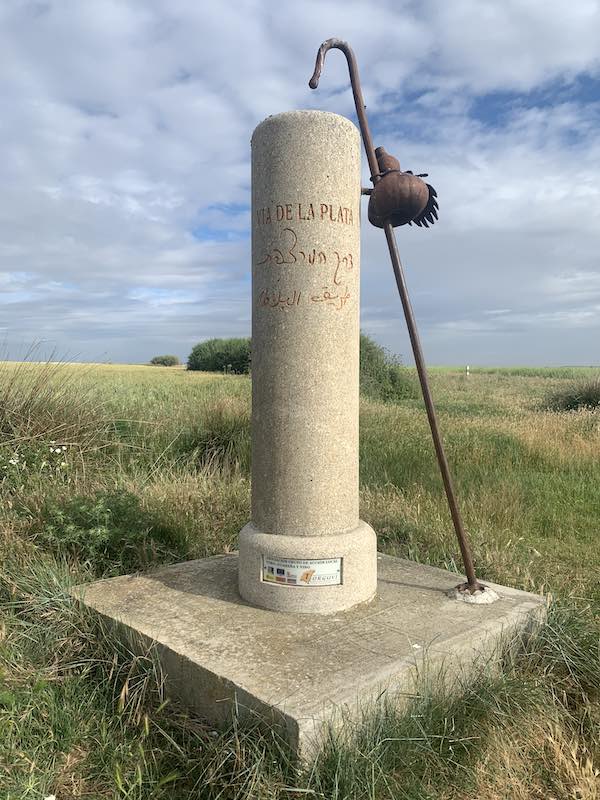
Via de la Plata route is well-marked, but from time to time it seeks high attention in order not to miss the marker.
The Camino de la Plata is marked with classic Camino yellow arrows and scallop shells. But, there are also some unique and extraordinarily beautiful Camino markers as well.
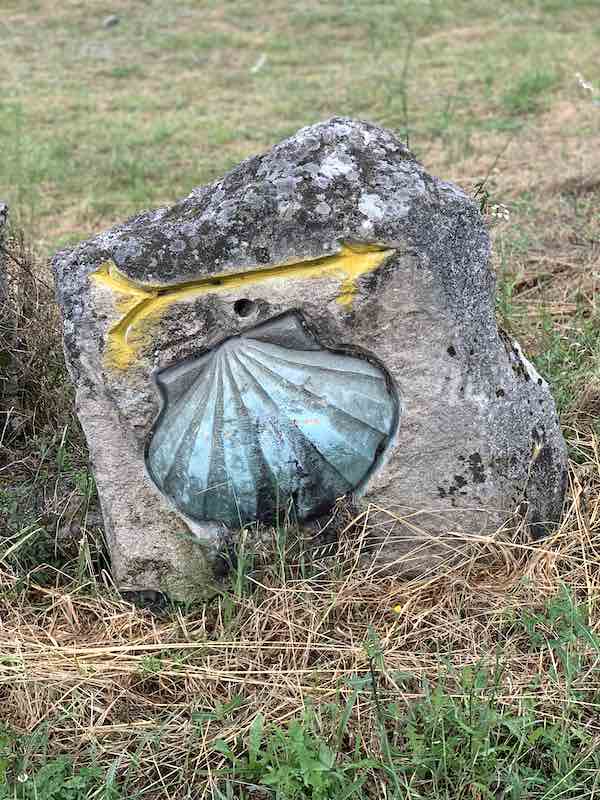
The Camino yellow arrow and scallops shell are sometimes replaced with stone pillars with ‘ Via de la Plata’ in Latin and Arabic letters and a metal pilgrim’s staff and pumpkin, short white stones with a Camino yellow shell and arrow, short stones an embedded shell tile, large stones with carved arty Camino arrow, stones with Camino carvings, large stones with the name of the place and greetings for pilgrims …
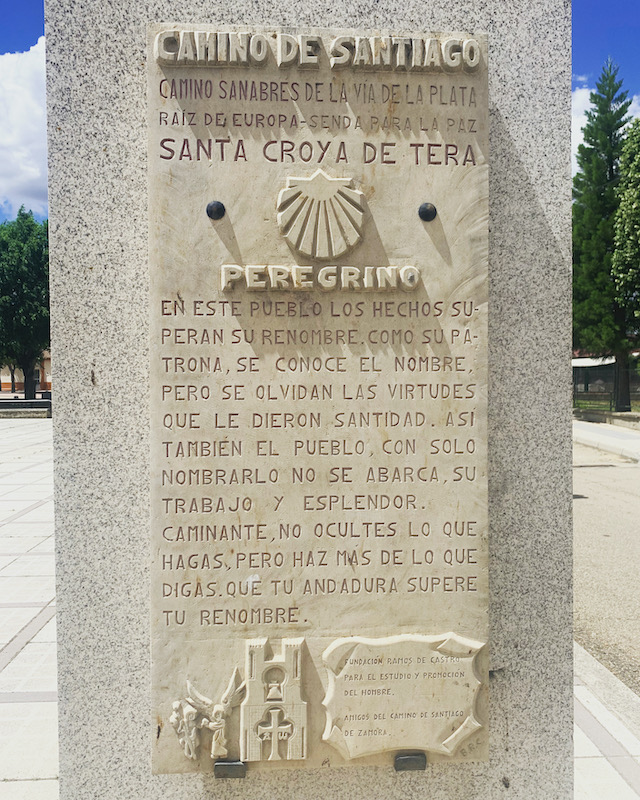
VIA DE LA PLATA STAGES
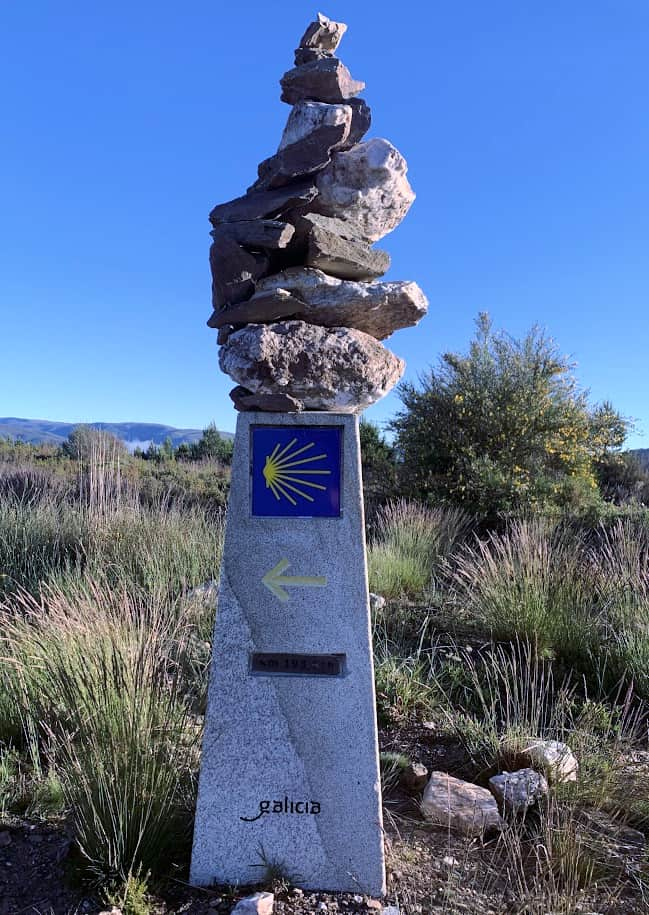
Camino Via de la Plata stages
VIA DE LA PLATA STAGES FROM SEVILLE TO SANTIAGO VIA ASTORGA
There are 38 stages in a total of Via de la Plata from Seville to Santiago de Compostela via Astorga.
Via de la Plata etapas:
- Stage 1: Seville – Guillena 13.4 mi (21.6 km)
- Stage 2: Guillena – Castilblanco de los Arroyos 11.4 mi (18.3 km)
- Stage 3: Castilblanco de los Arroyos – Almadén de la Plata 17.5 mi (28.2 km)
- Stage 4: Almadén de la Plata – Monesterio 20.8 mi (33.6 km)
- Stage 5: Monesterio – Fuente de Cantos 12.8 mi (20.7 km)
- Stage 6: Fuente de Cantos – Zafra 15 mi (24.2 km)
- Stage 7: Zafra – Villafranca de los Barros 12.2 mi (19.7 km)
- Stage 8: Villafranca de los Barros – Torremejía 16.7 mi (26.8 km)
- Stage 9: Torremejía – Mérida 9.5 mi (15.3 km)
- Stage 10: Merida – Alcuescar 22.3 mi (35.9 km)
- Stage 11: Alcuéscar – Cáceres 23.2 mi (37.4 km)
- Stage 12: Cáceres – Embalse de Alcántaran 21 mi (33.8 km)
- Stage 13: Embalse de Alcántara – Grimaldo 12.4 mi (20 km)
- Stage 14: Grimaldo – Carcaboso 18.8 mi (30.2 km)
- Stage 15: Carcaboso – Aldeanueva del Camino 23.8 mi (38.3 km)
- Stage 16: Aldeanueva del Camino – La Calzada de Béjar 13.5 mi (21.8 km)
- Stage 17: The Béjar Causeway – Fuenterroble de Salvatierra 12.5 mi (20.2 km)
- Stage 18: Fuenterroble de Salvatierra – San Pedro de Rozados 17.3 mi (27.9 km)
- Stage 19: San Pedro de Rozados – Salamanca 14.7 mi (23.6 km)
- Stage 20: Salamanca – El Cubo del Vino 22.6 mi (36.4 km)
- Stage 21: El Cubo del Vino – Zamora 19.6 mi (31.6 km)
- Stage 22. Zamora – Montamarta 12 mi (19.2 km)
- Stage 23: Montamarta – Granja de Moreruela 14 mi (22.6 km)
The La Via de la Plata branches to Astorga and to Sanabria at Granja de Moreruela
- Stage 24: Granja de Moreruela – Benavente 17 mi (26.6 km)
- Stage 25: Benavente – Alija del Infantado 13.9 mi (21 km)
- Stage 26: Alija del Infantado – La Bañeza 13 mi (22.2 km)
- Stage 27: La Bañeza – Astorga 15.4 mi (24.5 km)
The Via de la Plata (the Camino de la Plata) joins the French Way (the Camino Frances) in Astorga
- Stage 28: Astorga – Foncebadon 16.5 mi (25.8 km)
- Stage 29: Foncebadon – Ponferrada 16 mi (26.8 km)
- Stage 30: Ponferrada – Villafranca del Bierzo 15.6 mi (24.2 km)
- Stage 31: Villafranca del Bierzo – O Cebreiro 17.5 mi (27.8 km)
- Stage 32: O Cebreiro – Triacastela 12 mi (20.8 km)
- Stage 33: Triacastela – Sarria (por San Xil) 11 mi (17.8 km)
- Stage 34: Sarria – Portomarin 13 mi (22.2 km)
- Stage 35: Portomarín – Palas de Rei 15.7 mi (24.8 km)
- Stage 36: Palas de Rei – Arzúa 17 mi (28.5 km)
- Stage 37: Arzúa – O Pedrouzo 11.2 mi (19.3 km)
- Stage 38: O Pedrouzo – Santiago de Compostela 12 mi (19.4 km)
VIA DE LA PLATA STAGES FROM SEVILLE TO SANTIAGO VIA SANABRIA
There are 37 stages in total of the Camino de la Plata from Seviilla to Santiago via the Sanabres Way
- Stage 1: Seville – Guillena 13.4 mi (21.6 km)
- Stage 2: Guillena – Castilblanco de los Arroyos 11.4 mi (18.3 km)
- Stage 3: Castilblanco de los Arroyos – Almadén de la Plata 17.5 mi (28.2 km)
- Stage 4: Almadén de la Plata – Monesterio 20.8 mi (33.6 km)
- Stage 5: Monesterio – Fuente de Cantos 12.8 mi (20.7 km)
- Stage 6: Fuente de Cantos – Zafra 15 mi (24.2 km)
- Stage 7: Zafra – Villafranca de los Barros 12.2 mi (19.7 km)
- Stage 8: Villafranca de los Barros – Torremejía 16.7 mi (26.8 km)
- Stage 9: Torremejía – Mérida 9.5 mi (15.3 km)
- Stage 10: Merida – Alcuescar 22.3 mi (35.9 km)
- Stage 11: Alcuéscar – Cáceres 23.2 mi (37.4 km)
- Stage 12: Cáceres – Embalse de Alcántaran 21 mi (33.8 km)
- Stage 13: Embalse de Alcántara – Grimaldo 12.4 mi (20 km)
- Stage 14: Grimaldo – Carcaboso 18.8 mi (30.2 km)
- Stage 15: Carcaboso – Aldeanueva del Camino 23.8 mi (38.3 km)
- Stage 16: Aldeanueva del Camino – La Calzada de Béjar 13.5 mi (21.8 km)
- Stage 17: The Béjar Causeway – Fuenterroble de Salvatierra 12.5 mi (20.2 km)
- Stage 18: Fuenterroble de Salvatierra – San Pedro de Rozados 17.3 mi (27.9 km)
- Stage 19: San Pedro de Rozados – Salamanca 14.7 mi (23.6 km)
- Stage 20: Salamanca – El Cubo del Vino 22.6 mi (36.4 km)
- Stage 21: El Cubo del Vino – Zamora 19.6 mi (31.6 km)
- Stage 22. Zamora – Montamarta 12 mi (19.2 km)
- Stage 23: Montamarta – Granja de Moreruela 14 mi (22.6 km)
At Granja de Moreruela Via de la Plata branches to Astorga and to the Camino Sanabres
- Stage 24: Granja de Moreurela – Tabara 15 mi (25.1 km)
- Stage 25: Tabara – Santa Marta de Tera 14.2 mi (22.9 km)
- Stage 26: Santa Marta de Tera – Mombuey 22.4 mi (36.1 km)
- Stage 27: Mombeuy – Puebla de Sanabria 19.7 mi (31.7 km)
- Stage 28: Puebla de Sanbria – Lubian 18.4 mi (29.6 km)
- Stage 29: Lubian – A Gudina 14.7 mi (23.7 km)
- Stage 30: A Gudina – Laza 21.4 mi (34.4 km)
- Stage 31: Laza – Xunqueira de Ambia 20.5 mi (33 km)
- Stage 32: Xunqueira de Ambia – Ourense 13.5 mi (21.7 km)
- Stage 33: Ourense – Cea 13.1 mi (21.2 mi )
- Stage 34: Cea – O Castro 9 mi (14.5 km)
- Stage 35: O Castro – Silleda 17.4 mi (28 km)
- Stage 36: Silleda – Outeiro 14.9 mi (23.9 km)
- Stage 37: Outeiro – Santiago de Compostela 10.4 mi (16.7 km)
VIA DE LA PLATA STAGES FROM SEVILLE TO SANTIAGO VIA CAMINO ZAMORANO PORTUGUES
There are 38 stages in total from Seville to Santiago via Camino Portugues de la Via de la Plata
CAMINO PORTUGUES DE LA VIA DE LA PLATA (Zamora-Bragança-Verin) stages:
- Stage 1: Seville – Guillena 13.4 mi (21.6 km)
- Stage 2: Guillena – Castilblanco de los Arroyos 11.4 mi (18.3 km)
- Stage 3: Castilblanco de los Arroyos – Almadén de la Plata 17.5 mi (28.2 km)
- Stage 4: Almadén de la Plata – Monesterio 20.8 mi (33.6 km)
- Stage 5: Monesterio – Fuente de Cantos 12.8 mi (20.7 km)
- Stage 6: Fuente de Cantos – Zafra 15 mi (24.2 km)
- Stage 7: Zafra – Villafranca de los Barros 12.2 mi (19.7 km)
- Stage 8: Villafranca de los Barros – Torremejía 16.7 mi (26.8 km)
- Stage 9: Torremejía – Mérida 9.5 mi (15.3 km)
- Stage 10: Merida – Alcuescar 22.3 mi (35.9 km)
- Stage 11: Alcuéscar – Cáceres 23.2 mi (37.4 km)
- Stage 12: Cáceres – Embalse de Alcántaran 21 mi (33.8 km)
- Stage 13: Embalse de Alcántara – Grimaldo 12.4 mi (20 km)
- Stage 14: Grimaldo – Carcaboso 18.8 mi (30.2 km)
- Stage 15: Carcaboso – Aldeanueva del Camino 23.8 mi (38.3 km)
- Stage 16: Aldeanueva del Camino – La Calzada de Béjar 13.5 mi (21.8 km)
- Stage 17: The Béjar Causeway – Fuenterroble de Salvatierra 12.5 mi (20.2 km)
- Stage 18: Fuenterroble de Salvatierra – San Pedro de Rozados 17.3 mi (27.9 km)
- Stage 19: San Pedro de Rozados – Salamanca 14.7 mi (23.6 km)
- Stage 20: Salamanca – El Cubo del Vino 22.6 mi (36.4 km)
- Stage 21: El Cubo del Vino – Zamora 19.6 mi (31.6 km)
After Zamora starts the Camino Portugues de la Via de la Plata
- Stage 21: Zamora – Almond 23.6 km
- Stage 22: Almond – Ricobayo de Alba 18.2 km
- Stage 23: Ricobayo de Alba – Fonfria (Zamora) 20.1 km
- Stage 24: Fonfría (Zamora) – Alcañices 22 km
- Stage 25: Alcañices – Quintanilha 24.9 km
- Stage 26: Quintanilha – Bragança 24 km
- Stage 27: Bragança – Vinhais 28.1 km
- Stage 28: Vinhais – Segirei 25.4 km
- Stage 29: Segirei – Verin 28.2 km
Camino Zamorano Portugues joins the Camino Sanabres (the Verin variant) in Verin
- Stage 30: Verin – Viladerrei 21.2 km
- Stage 31: Viladerrei – Xinzo de Limia 15.7 km
- Stage 32: Xinzo de Limia – Allariz 20.5 km
- Stage 33: Allariz – Ourense 22.1 km
- Two Variants of Camino Sanbres join in Ourense
- Stage 34: Ourense – Cea 13.1 mi (21.2 mi )
- Stage 35: Cea – O Castro 9 mi (14.5 km)
- Stage 36: O Castro – Silleda 17.4 mi (28 km)
- Stage 37: Silleda – Outeiro 14.9 mi (23.9 km)
- Stage 38: Outeiro – Santiago de Compostela 10.4 mi (16.7 km)
VIA DE LA PLATA ACCOMODATION
There are public pilgrim hostels (albergues de peregrinos), private hostels, tourist hostels, and hotels in bigger towns along Via de la Plata.
As I already mentioned, the Sanabres Way is the most popular variant of the Via de La Plata route. So, here I am listing the most-sought after albergues and some optional hotels along the Camino del Plata, Sanabres Way.
VIA DE LA PLATA ACCOMMODATION FROM SEVILLE TO SANTIAGO VIA SANABRES WAY
| Stage | Stage | Place (village -town) to sleep | Albergue | Hotel |
| Seville | Seville | Hospedería Convento de Santa Rosalía (address: C. Cardenal Spínola, 8) | Petit Palace Puerta de Triana (check out Booking.com ) | |
| Stage 1 | Seville – Guillena | Guillena | Albergue Luz del Camino (14 €; address C. Federico García Lorca, 8) | |
| Stage 2 | Guillena – Castilblanco de los Arroyos | Castilblanco de los Arroyos | Albergue de peregrinos de Castilblanco de los Arroyos (donation; Av. Antonio Machado, s/n ) | |
| Stage 3 | Castilblanco de los Arroyos – Almadén de la Plata | Almadén de la Plata | Albergue municipal de Almadén de la Plata (10 €; C. Cervantes, s/n ) | Hotel El Romeral ( check out Booking.com ) |
| Stage 4 | Almadén de la Plata – Monesterio | Monasterio | Albergue Las Moreras (12,50 €; address: Ronda de Segura de León, 3) | Hotel Leo ( check out Booking.com ) |
| Stage 5 | Monesterio – Fuente de Cantos | Fuente de Cantos | Pensión Casa Vicenta (15 €, address; C. Real, 33) | El Zaguán de la Plata ( check out Booking.com) |
| Stage 6 | Fuente de Cantos – Zafra | Zafra | Albergue de peregrinos de Zafra (Vincent Van Gogh) (10 €; address: Av. de la Estación, 17) | Hotel Plaza Grande ( check out Booking.com ) |
| Stage 7 | Zafra – Villafranca de los Barros | Villafranca de los Barros | Albergue turístico La Almazara ( check out Booking.com ) | Hotel Acosta Ciudad de la Música (check out Booking.com ) |
| Stage 8 | Villafranca de los Barros – Torremejía | Torremejía | Albergue Rojo Plata ( check out Booking.com ) | |
| Stage 9 | Torremejía – Mérida | Mérida | Albergue de peregrinos Molino de Pancaliente (10 € address: Av. José Fernández López, s/n) | Vettonia Hotel (check out Booking.com ) |
| Stage 10 | Mérida – Alcuéscar | Alcuéscar | Casa de Acogida de los Esclavos de María y de los Pobres (donation; address: Av. de Extremadura, 2) | |
| Stage 11 | Alcuéscar – Cáceres | Cáceres | Albergue juvenil Ciudad de Cáceres (16 €; address: Av. de la Universidad, s/n) | Hotel Don Carlos Cáceres ( check out Booking.com ) |
| Stage 12 | Cáceres – Embalse de Alcántara | Embalse de Alcántara | Albergue del Embalse de Alcántara (15 €; Ctra. N-630, Km 519,8 ) | Hostel Cañaveral (check out Booking ) |
| Stage 13 | Embalse de Alcántara – Grimaldo | Grimaldo | Albergue de peregrinos de Grimaldo (donation; address: Ctra. N-630, s/n ) | La Posada de Grimaldo (check out Booking ) |
| Stage 14 | Grimaldo – Carcaboso | Carcaboso | Albergue Señora Elena (13 €; address: Ctra. de Plasencia, 23-27) | Hostal Ciudad de Cáparra (check out Booking.com) |
| Stage 15 | Carcaboso – Aldeanueva del Camino | Aldeanueva del Camino | Albergue La Casa de Mi Abuela ( check out Booking.com ) | El Mullaero (check out Booking.com ) |
| Stage 16 | Aldeanueva del Camino – La Calzada de Béjar | La Calzada de Béjar | Albergue Alba – Soraya (12 €; Camino Real de la Plata) | Casa rural Jorge ( check out Booking.com ) |
| Stage 17 | La Calzada de Béjar – Fuenterroble de Salvatierra | Fuenterroble de Salvatierra | Albergue parroquial Santa María (donation; address:C. de la Iglesia, 3 ) | Casa Rural Paqui (25 €; address: C. La Fuente, 1) |
| Stage 18 | Fuenterroble de Salvatierra – San Pedro de Rozados | San Pedro de Rozados | Albergue Mari Carmen (10 €; address: C. Oriente, 8) | Hotel Rural VII Carreras by Vivere Stays (check out Booking.com ) |
| Stage 19 | San Pedro de Rozados – Salamanca | Salamanca | Albergue(solapa activa) | Hotel Emperatriz I (check out Booking.com) |
| Stage 1 | Salamanca – Vino del Cubo | Vino del Cubo | Albergue Torre de Sabre (Check out Booking.com | |
| Stage 2 | Vino del Cubo – Zamora | Zamora | Albergue de peregrinos de Zamora (Donativo; address: C. Cuesta de San Cipriano) | Hostal Don Rodrigo ( check out Booking.com) |
| Stage 3 | Zamora – Montamarta | Montamarta | Albergue de peregrinos de Montamarta (5 €, Address: Ctra. N-630, s/n ) | Vivienda Turística El Asturiano Zamora ( check out Booking.com ) |
| Stage 4 | Montamarta – Granja de Moreruela | Granja de Moreruela | Albergue de peregrinos de Granja de Moreruela (6 EURO; Address: Av. Ángel de la Vega, s/n) | Donde Victor Luna (Check out Booking ) |
| Stage 5 | (Camino Sanabres ) Granja de Moreruela – Tabara | Tabara | Albergue de peregrinos de Tábara (Donation; address: Camino Sotillo, s/n) | El Roble Hotel (check out Booking.com ) |
| 6 | Tabara – Santa Marta de Tera | Santa Marta de Tera | Albergue de peregrinos de Santa Marta de Tera (5 €, address: C. de la Iglesia, 10) | |
| 7 | Santa Marta de Tera – Mombuey | Mombeuy | Albergue de peregrinos de Mombuey (Donation: address: C. de la Iglesia, s/n) | Hotel La Ruta ( www.hotellaruta.com ) |
| 8 | Mombuey – Puebla de Sanabria | Puebla de Sanabria | Albergue Casa Luz ( 12 €, address: C. Padre Vicente Salgado, 14 ) | Hotel Los Perales ( check out Booking.com ) |
| 9 | Puebla de Sanabria – Lubian | Lubian | Albergue de peregrinos de Lubián ( 5 €, address: C. de la Cruz, s/n ) | Casa Mariana (check out Booking.com) |
| 10 | Lubian – A Gudina | A Gudina | Albergue de peregrinos de A Gudiña ( 8 €; Rúa Beato Sebastián de Aparicio, s/n ) | HOTEL BRUMA II ( check out Booking ) |
| 11 | A Gudina – Laza | Laza | Albergue de peregrinos de Laza ( 8 €; address: Rúa do Toural, s/n ) | El Camino (check out Booking.com ) |
| 12 | Laza – Xunqueira de Ambia | Junqueira de Ambia | Albergue de peregrinos de Xunqueira de Ambía ( 8 €; address: C. Asdrúbal Ferreiro, s/n) | Vivienda de uso turístico Xunqueira De Ambía ( check out Booking.com ) |
| 14 | Xunqueira de Ambia – Ourense | Ourense | Albergue de peregrinos de Ourense (8 €; address: Rúa da Barreira, 12 ) | Hotel Novo Cándido ( check out Booking.com ) |
| 15 | Ourense – Cea | Cea | Albergue de peregrinos de Cea (8 €; address: C. Santo Cristo, 5 ) | Casa Mañoso (check out Booking.com ) |
| 16 | Cea – O Castro | O Castro | Albergue de peregrinos de Castro Dozón ( 6 €; address: Ctra. N-525, s/n ) | |
| 17 | O Castro – Silleda | Silleda | Albergue Santa Olaia (10 €; address: Av. del Parque, 17 ) | Exe Vía Argentum ( check out Booking.com ) |
| 18 | Silleda – Outeiro | Outeiro | Albergue de peregrinos de Outeiro (8 €; address: Outeiro, s/n ) | |
| 19 | Outeiro – Santiago de Compostela | Santiago de Compostela | Albergue Seminario Menor ‘(check out Booking.com ) |
BEST TIME TO WALK VIA DE LA PLATA
The best seasons for walking Via de la Plata are spring and autumn.
Summer is not recommended for walking the Via de la Plata route, because of the extreme heat. Andalucia and Extramadura record frequently summer air temperatures above 40 C degrees in shadow. The terrain is primarily flat but often without shadows (no trees). In addition, the Camino stages are long with no facilities between the stages. Unfortunately, heat strokes caused some pilgrims’ deaths in the past.
Therefore, Via de la Plata is not recommended for walking from June to September (especially not in July and August).
The best months to walk Via de la Plata are April, May, and October. The most popular month for starting walking Camino Via de la Plata is April.
PACKING LIST FOR CAMINO VIA DE LA PLATA
I hiked Camino del Norte in the summer of 2021. The next year, I hiked Via de la Plata, and Santiago Fisterra in June 2022 with the same items.
I am a light traveler who enjoys minimalism and who always recommends ultralight Camino packing.
Honestly, there’s no need to pack anything else but necessary items. You can always buy something if needed as you walk through the villages, towns, and cities along the Caminos.
Please do yourself a favor and don’t overpack.
Read my ultimate Camino de Santiago packing list!
VIA DE LA PLATA MAP

Camino de la Plata map
During my Via de la Plata hike I heard about Camino Ninja App for the first time. To tell the truth, all pilgrims along the route were using the app.
One day I decided to give try to Camino Ninja App, and I downloaded the app.
Camino Ninja App is a free mobile phone app with offline GPS tracker maps of various Camino routes. It tracks your steps along the route, so at any moment you can check whether you are on the correct path or not.
Camino Ninja App offers not only maps but also info on accommodations along, with available bars, restaurants, groceries, … and even info on the elevation of the stages. This app is a great tool for planning the Caminos.
I used Camino Ninja App on Camino de Santiago Via de la Plata and Camino de Fisterra, and I can highly recommend the app as a valuable resource for hiking the Caminos.
- Sleep Like Royalty: The 13 Fairytale Castle Hotels in Tuscany You Can Actually Book - October 1, 2025
- Agriturismo Tuscany: 15 Stunning Farm Stays That Will Make You Return Again and Again - September 30, 2025
- 13 Cave Hotels in Matera Italy You Have to See to Believe - September 27, 2025

